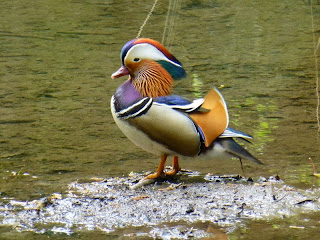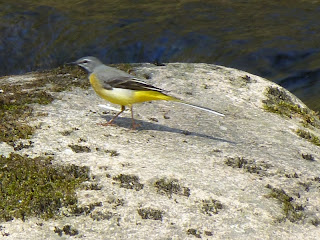The cafe remains closed but the small ice cream/ coffee shed just below the car park has opened, no pasties but at least I can now get a hot drink. And I had a moth in the toilet block at last in the form of a very nice common carpet.
Common Carpet
Tuesday 21st May and the last day of my annual leave so I bribed David to take me to Yarner Wood with the promise of lunch and cake at the cafe in Bovey Tracey. Within 10 minutes of arriving at Yarner Wood and walking up the footpath from the car park to the new footbridge I had seen and heard my 2 target birds - wood warbler and pied flycatcher.The male pied flycatchers were vocal and showy and mobile as they sang around the nest boxes by the footpath and I managed to see 2 duller females too. The males are surprisingly tame and seem quite unperturbed by people walking nearby, giving some excellent views.
Male Pied Flycatcher
Also showing very well was a wood warbler, singing constantly from trees by the footpath as it flitted through the canopy catching insects. It had colour rings on its legs as part of the RSPB ringing scheme to try and ascertain why the numbers of wood warblers are plummeting so dramatically. It had an orange ring above a silver ring on its left leg and a light blue ring above a black ring on its right leg and on e-mailing the sighting to Malcolm Burgess, the ringing scheme co-ordinator, he has confirmed the bird was ringed as a fledgling last year at Yarner Wood. Amazing to think it has flown all the way to Africa and back.
Wood Warbler
Wood Warbler
I heard another wood warbler singing briefly nearby while watching the colour ringed bird and later saw another colour ringed bird moving quickly through the undergrowth before being lost from sight. This bird had 2 orange rings on its right leg but I couldn't catch a view of its left leg but Malcolm has confirmed that it bred last year at Blackpool Wood (not sure where that is!) but this year has settled in Yarner Wood. I also heard another bird singing briefly near the car park so there were at least 2, possibly 4, birds present in a relatively small area. I only hope the ringing scheme provides some useful information to help save the wood warbler from disappearing altogether, they are such beautiful birds and one of my all time favourites.Also seen were a spotted flycatcher, a nuthatch, a buzzard, a mistle thrush and a great spotted woodpecker. On the heathland above the car park a pair of stonechats were very vocal, presumably with a nest nearby, while I flushed a tree pipit bathing in a small pool which gave some nice views as it preened in a small tree.
Tree Pipit
On the pond by the car park a pair of Mandarin duck were keeping watch on a lone, small duckling while a pair of grey wagtails were collecting nesting material and perching on the rooftops of the nearby cottages.
Female Mandarin Duck
Male Mandarin Duck
A single holly blue, small white and comma were on the wing but on the journey home I saw male orange tips and brimstones by the roadside near Bovey Tracey. I also saw some early purple orchids by the side of the A38 near Ashburton.
Early Purple Orchid
I've also had the moth box out in the back yard on the 21st May and had my first yellow barred brindle of the year along with a common quaker and a new moth for me, a clouded drab, rather worn but ID'd with the help of the Back Garden Moth Community Forum.
Common Quaker
A faded Clouded Drab




















































